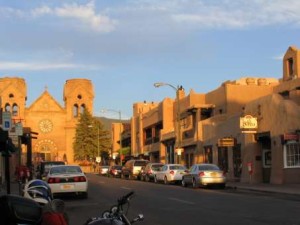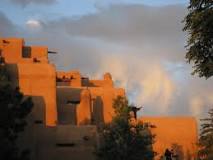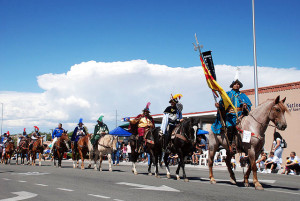History is not about the past; it is about arguments we have about the past. Ira Berlin, The Long Emancipation
I’ve been visiting Santa Fe, New Mexico for about 30 years. From the first I was enchanted by the ambiance, the weather (in all seasons), the food, the architecture, the art, the museums, the vivid and apparently seamless blending of Native American, Spanish, and Anglo cultures.

Downtown Santa Fe captures the blend of cultures in the adobe architecture, the cathedral built by the Spanish, and hotel La Fonda, built to accommodate/attract tourists arriving first by rail, now by air and car.
Since my first visit in the late 1980s the world has been transformed profoundly; a global critique of culture and how it is interpreted has matured; and I have changed from a new(ish) museum professional to one who is certainly older but also (I hope) somewhat more experienced. In the last couple of visits I’ve begun to detect some fissures in the cultural mosaic. They were there all along, but I didn’t see them. It took the discussions of racism and contested histories of this past year in particular to help me focus, during my most recent visit, on issues of race and culture in the Santa Fe context.
Mostly my husband and I come to Santa Fe as tourists seeking the beauty and refreshment of its ambiance. We especially love the museums, which in our experience have grown and flourished in their collections, modes of interpretation, and community connections. But I can’t help bringing my professional self along, and she and I had an interesting experience this time, not in a museum but in a cultural event that drew on my museum background.
Walking tours attract me as a bee to honey, and I joined about 100 fellow bees (mostly local, by a show of hands) early one evening for an exploration of the blend of architectural styles that make Santa Fe so visually fascinating. The tour, led by an architect, was excellent. I was excited about sharing all I had learned with my husband on our next day’s walk. It turned out we were staying in a neighborhood with a mix of all the styles the guide had discussed.
Toward the end of the tour, our group viewed a series of shops under a portico near the Cathedral. Our guide pointed out that they formed a wall that went around the block, enclosing a plaza within. He said we would find many of these enclosed spaces in this area, and that while these plazas provided interior light and air, their main function was protection from “marauding Indians,” a phrase he repeated a number of times. As we continued to walk, I asked him privately if enclosed areas with gardens and fountains were not a common architectural feature of most all the countries bounded by the Mediterranean. This form had come from Arabic cultures through European cultures, especially Spain, to the Americas, and at its root had nothing to do with Indian violence. The guide agreed, but once again emphasized that the main purpose of such enclosures in the Southwest was protection from Indian attacks. A woman on the tour who had overheard our conversation insisted that “marauding Indians” was indeed the correct term. When I responded that “marauding” had a connotation of random and senseless attacks, and that maybe the Indians had some reasons for their violence, I could see this line of thinking made no sense to her at all.
What follows is a condensed version of conversations I had with the guide at the end of the tour, and with two women who overheard the discussion. I told the guide I was not objecting to his discussion of Indian attacks on both Spanish and Anglo settlers in Santa Fe and its surroundings, but I wondered if the term “marauding” was necessary. I asked if he might have spoken differently if he had been addressing a group of Native Americans. He replied that he would have said exactly the same thing: “It’s history. They are not marauding today.”
The woman who had defended the word “marauding” before began to tell me how vicious and unrelated to white settlement the Indian attacks were: “young toughs who just wanted to steal.” When another woman on the tour, an archaeologist, commented on how badly the Spanish had treated Native Americans, the first lady announced proudly that she was a daughter of the Conquistadors, and that the treatment of Indians by the Spanish was of a completely different order. “And,” she added, “if a group of Indians had been on the tour, they would have agreed completely with the use of the word ‘marauding.'”
As we all parted ways we noted as a group that the “Fiestas de Santa Fe.” began the next day. This 3-day festival commemorates, according to the website, “the peaceful reconquest of the capital by General Don Diego de Vargas in 1692.” The Pueblos had held Santa Fe and surrounding communities for 12 years, since their successful revolt against the Spanish in 1680. The 3-day event is a blaze of color–flags, clothing, tents–and filled with religious events, historic reenactments, food, music, and crafts. The Santa Fe New Mexican entertainment section had an interesting story about the event, including interviews by historians discussing the cultural tensions that continue to infuse the celebration, and questioning the term “bloodless” that is often used to describe the reconquest. The same paper covered a silent protest by Native Americans that occurred during this year’s festival.
There is now an Indian princess in the Hispanic festival queen’s court. Yet the center of festivities is the main Plaza in Santa Fe, built around a monument to the “heroes fallen in the glorious battles with savage Indians in the territories.” The word “savage” was chiseled out a few years ago in response to Native protests, so the stone in front of the word “Indian” is noticeably lighter and rougher.
The phrase “marauding Indians” stayed with me. Was I just an oversensitive interloper from the East who knew nothing about local sensibilities? So I went the next day to the Museum of Contemporary Native Arts just around the corner from the Plaza. Through staff there I found confirmation that this phrase was indeed offensive. We talked about the use of language in cultural interpretation and the stories told and left untold in our cultural institutions, our celebrations, our monuments. Staffing the front desk was a museum studies major at IAIA, the Institute of American Indian Art in Santa Fe. The Museum is affiliated with IAIA, and the student talked about discussions in her museum classes related to this issue. Through her I found Jessie Ryker-Crawford (White Earth Chippewa), Associate Professor of Museum Studies at IAIA, and we had a wonderful talk about race, museum interpretation, and cultural appropriation, and about how these topics are addressed up front in the IAIA Museum Studies Program. I’ve asked Jessie to contribute to the conversation, so she’ll be writing a guest post in the near future.
I would love to hear any comments or questions raised by this post. For me the following topics occur:
— History is indeed the past we argue about, and museums generally fail to articulate these arguments. I think this is changing, although slowly. (As an added note I see evidence of this change in some of Santa Fe’s museums, but that is a topic for another posting.)
— Our nation’s contested history has a huge impact on personal identity, and this continues through centuries. Memories die hard.
–The twin legacies of racism and colonialism weave through almost every part of our history; they are difficult for white culture to acknowledge and address, but this is not an excuse.
–Terms like “intersectionality” and “white privilege,” used for many years in academic circles, are becoming more common in everyday discourse as their relevance is finally being acknowledged.
Your thoughts? You can comment at www.museumcommons.com or @gretchjenn
Your thoughts? You can comment at www.museumcommons.com or @gretchjenn


Hi Gretchen,
You’re right, and the reactions of the guide and first woman, that “marauding” is the proper term, and in any event, it is “history”, I think reflects the truism, “History is written by the victors”.
I just finished reading Gilbert King’s “Devil in the Grove” about Thurgood Marshall and the Groveland Boys case in the late 1940s South. Same thing, where Southern whites were certain blacks were inferior, and were willing to say or do anything to keep them “in their place”, including framing them for acts they didn’t commit, and killing them randomly without cause.
I fear it is a bit in our “American exceptionalism” DNA, difficult to stamp out, even in our relatively enlightened modern day times. It’s worth the effort, anyway, and I think you’re right that at least part of the battlefield is located in our museums and our never-ending attempt to “get history right”, no matter the prejudice we encounter.
Thanks for the post and your thoughts.
Thanks, Gil, I appreciate your comments and thoughts as well. The battlefield is indeed in our museums and other cultural institutions. Hope to see you next summer, by the way, when i come for next Siderius Reunion. G